The Leshan Giant Buddha, also known as the Lingyun Giant Buddha or the "Great Maitreya Stone Statue of Lingyun Temple in Jiazhou," is located on the eastern bank of the Minjiang River in Leshan City, Sichuan Province, adjacent to Lingyun Temple and at the confluence of the Dadu River, Qingyi River, and Minjiang River. This seated statue of Maitreya Buddha stands at a total height of 71 meters, making it the largest cliff-carved statue in China.
The construction of the Leshan Giant Buddha began in the first year of the Kaiyuan era of the Tang Dynasty (713) and was completed in the nineteenth year of the Zhenyuan era (803), spanning approximately ninety years. The head of the Buddha is as high as the mountain, with a height of 14.7 meters and a width of 10 meters. It boasts 1,051 hair knots and ears that stretch 7 meters long. Carved into the cliff facing the river, the Buddha exudes a solemn and majestic aura.
On the cliff walls along the river on both sides of the Giant Buddha, there are also two Guardian Kings statues, each standing over 16 meters tall. To the right of the Giant Buddha, there is a zigzag ancient plank road known as the "Nine Bends Plank Road" This road was left behind during the construction of the Giant Buddha in the Tang Dynasty and was carved along the precipitous cliff. It twists and turns nine times, making it exceptionally steep.
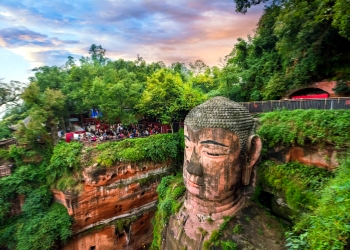
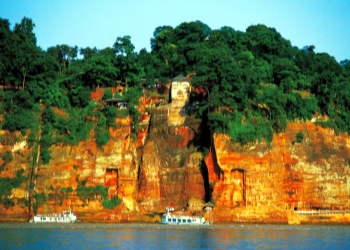
Attractions in Leshan Giant Buddha Scenic Area
The Leshan Giant Buddha Scenic Area boasts numerous scenic spots, each with its unique charm and well worth a visit. However, some visitors may not have enough time to explore all the attractions. Therefore, here is a brief introduction to a few representative scenic spots among them!
Lingyun Temple
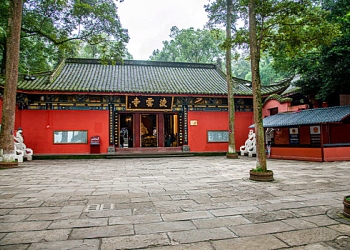
Lingyun Temple, also known as Giant Buddha Temple (Dafo Temple), sits atop Lingyun Mountain, mere steps away from the illustrious head of the Leshan Giant Buddha. Its history dates back to the early Tang Dynasty (618-907), spanning over 1,400 years, even preceding the construction of the Giant Buddha itself. It includes Tianwang Hall, Daxiong Hall, and the Depository of Buddhist Sutras.
Upon entering Lingyun Temple, travelers are immediately enveloped in a serene atmosphere, allowing them to immerse themselves in the rich Buddhist culture and heritage. It is a perfect place to unwind before heading out for a hike or continuing their journey. Whether you are a devout Buddhist or simply seeking a peaceful respite, Lingyun Temple offers a unique experience that is sure to leave a lasting impression.
Nine Bends Plank Road
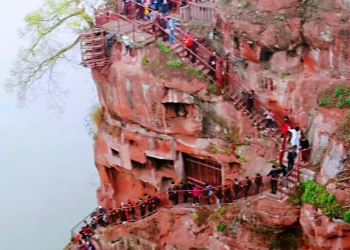
Nestled on the right cliff of the Leshan Giant Buddha, the Nine Bends Plank Road snakes its way alongside the colossal statue. Carved into the rock, this crooked plank road features nine distinct turns, earning it its moniker. The road's width varies, with the broadest section measuring 1.45 meters and the narrowest just 0.6 meters, allowing only a single person to pass through at a time. Along its length, travelers will encounter a total of 278 stone steps. Starting from the Buddha's head, the plank road guides visitors on a journey down to its feet. However, it's worth noting that during weekends and public holidays, the crowds of tourists can make this hike a lengthy and slow affair, potentially lasting anywhere from 2 to 4 hours.
Wuyou Temple
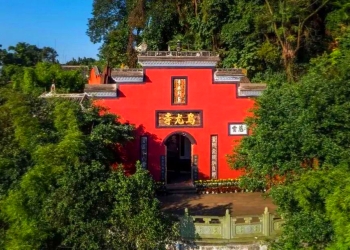
Wuyou Temple is nestled atop Wuyou Mountain, dating back to the Tang Dynasty. Once you've descended the Nine Bends Plank Road to the feet of the Giant Buddha, continue walking to its left, traversing the 500-meter-long Lingyun Plank Road. At the end of this journey, you'll find Wuyou Temple tucked away in the west. It is surrounded by lush bamboo and fragrant wintersweet and comprises seven halls, each exuding a sense of tranquility. In contrast to the bustling Lingyun Temple, Wuyou Temple offers a more secluded and serene experience. With fewer visitors and pristine air, it's a perfect place to unwind, rejuvenate, and immerse yourself in the crisp, fresh air.
Giant Sleeping Buddha
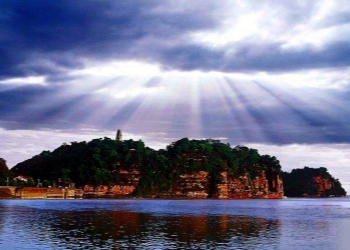
A fascinating discovery made by tourists several years ago revealed that Wuyou Mountain, Lingyun Mountain, and Guicheng Mountain, situated behind the Leshan Giant Buddha, have collectively formed a breathtaking image resembling a sleeping Buddha on the water's surface. The head of this Giant Sleeping Buddha is embodied by Wuyou Mountain, where the stones, bamboo forest, and temples create the illusion of the Buddha's five sense organs. Lingyun Mountain takes shape as the body, while Guicheng Mountain completes the figure as the foot. Stretching over 1300 meters from south to north, with its head facing south, this sleeping Buddha is a sight to behold.
Oriental Buddha Capital
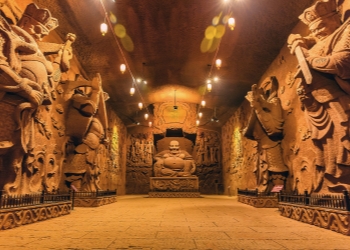
The Oriental Buddha Capital is a mere kilometer away from the illustrious Leshan Giant Buddha. Spanning an area exceeding 20,000 square meters, this stone carving theme park seamlessly blends religious art, sculpture art, and garden art into a captivating whole. The park boasts over 3000 Buddha statues crafted from diverse materials such as rock, bronze, clay, and jade, each embodying the artistic essence of Chinese and Southeast Asian Buddhism. At the heart of Oriental Buddha Capital stands a magnificent 170-meter-long sleeping Buddha statue. This colossal sculpture is not just a visual spectacle; it holds the distinction of being the largest and longest sleeping Buddha statue in the world.
How to Travel Leshan Giant Buddha
There are two ways to tour the Leshan Giant Buddha. The first way is to take a dedicated cruise or speedboat from Leshan Port and observe the Giant Buddha and the Sleeping Buddha from the river, which allows you to see the full view of both. The second way is to walk along the Nine Bends Plank Road, which brings you closer to the Giant Buddha. Although the viewing angles and heights differ between the two methods, no matter which one you choose, the sight of a giant Buddha will be a breathtaking spectacle. If you choose to explore the scenic area on foot, after passing through the Nine Bends Plank Road and admiring the Leshan Giant Buddha, you can proceed to Lingyun Temple.
Best Time To Visit
The ideal time to visit is between March and November. In Spring, the scenery is particularly captivating as numerous flowers bloom, and the sea of clouds atop the mountain offers breathtaking views. From May to June, the weather is mostly sunny, not overly hot, and the mountain temperatures are cooler compared to the city center. Autumn boasts crisp, clear weather, making it a perfect season to witness the sea of clouds, sunrise, and sunset atop the mountain.
It is highly advisable to steer clear of the peak tourist periods in China, such as the Spring Festival, May 1st to May 7th, and October 1st to October 7th. During these golden weeks, the scenic spot is inundated with domestic tourists, and visitors often have to wait in queues for up to 4 hours just to reach the feet of the Buddha.
Travel Tips
Best Seasons to Visit: March to November
Recommended Visiting Time: 4 hours
Opening Time: 07:30 ~ 18:30 (April 1 ~ October 7)
08:00 ~ 17:30 (October 8 ~ March 31)
Tickets Price: 80 CNY/person
Address: No.2435 Lingyun Street, Shizhong District, Leshan, Sichuan




































